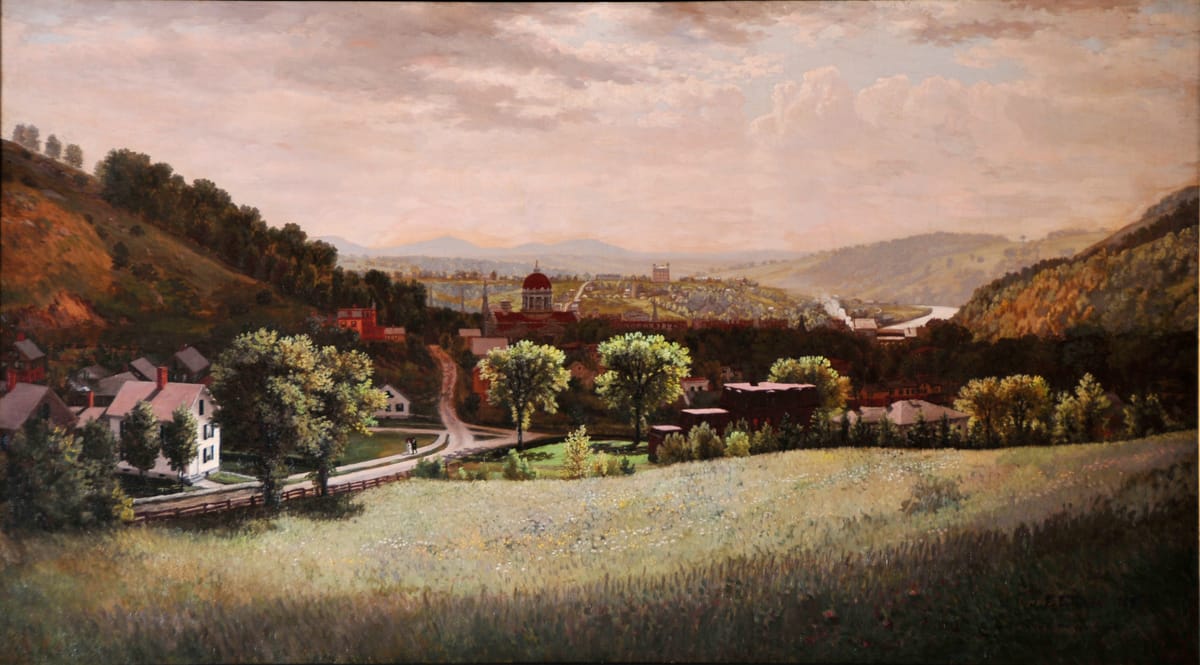A painted landscape
There is a tension that exists while living in the midst of a painting

Vermont’s landscape is famed for its beauty.
For centuries, it’s been both a destination and inspiration for artists of all stripes. Seen through their eyes, the Green Mountain State is many things: pastoral countryside dotted with idyllic towns and villages in oil landscapes, riots of color gracing the sides of buildings, and sculptures of stone hewn from the ground. It’s a canvas for artists to interpret who we are as a collective body of people living between the mountains and the forests. Understanding Vermont through the eyes of artists throughout the ages helps us to understand not just the physical dimensions of the landscape, but of how they saw themselves in it throughout the state’s history.

Some of the earliest-known artwork in the state can be found along the riverbanks of Bellows Falls and Brattleboro: petroglyphs carved into the rocks by members of the Western Abenaki tribes. In his 2001 PhD dissertation, The Petroglyph Sites of Bellows Falls and Brattleboro, Vermont, Dr. Thomas Earl Larose notes that this sort of rock art denoted “such things as sacred sites connected to mythology, crossroads, or historical events,” and that these markings were left in places where they were oriented in ways that travelers could see them, presumably communicating the stories to them as they passed.
When settlers arrived in North America, they sketched the landscape in their own ways. Mapmakers reproduced the coastlines and political boundaries on paper, while others sketched out the landmarks and towns that they saw. “First Bridge at Bellows Falls” and “View of Bellows Falls,” drawn by an anonymous artist in 1805 shows off the buildings nestled alongside the trees and rivers, while another painted a bustling scene in 1825’s “View of Cavendish.”

Born in 1818, Scottish-born painter James Hope explained that the “exquisite scenery and lordly tales of my Scottish homeland sparked a lifelong attachment for reverent delight in Nature so Attuned,” and after arriving in Vermont as a teenager, he demonstrated his skill as an artist from a young age. After injuring himself chopping wood, Hope tried his hand at painting, soon establishing himself as a noteworthy portrait painter. In her 1984 dissertation, James Hope: nineteenth century American painter, Elizabeth Theriault Strum noted that Hope settled his family in the Rutland area likely “due to its natural scenery...the beauty of the area and the mineral spa of nearby Clarendon attracted tourists during the summer months.”
Others followed: itinerant, self-taught painter James Franklin Gilman made a living travelling from house to farm, sketching and painting everyday scenes of 19th century Vermont life, prompting biographer Adele Godchaux Dawson to highlight the attention to detail he brought to those pieces: “his quiet assemblage of detail in the foreground, middle ground and far distance gives his paintings a quality of total recall rather than casual observation.” Italian-born artist Luigi Lucioni began his career in New York City in the early 20th century, but began traveling to Vermont in the 1930s, writing “it was like seeing the mountainsides of my birthplace. I was reborn in this majestic setting and I fell in love with Vermont.” He returned year after year to render Vermont’s landscapes in oil on canvas.
Vermont’s artists didn’t limit themselves to paintings to express themselves. Rockingham’s Burial Ground is home to some of the oldest graves in the state, and it’s a wonder to behold. The slate gravestones feature intricate etchings created by a team of dedicated stone carvers who etched the names and beliefs of the early settlers who passed. Nearly a hundred miles away, Italian and Scottish stone carvers in Barre spent their lives honing their craft on the granite they hauled out of the hillsides, transforming the city into an outdoor sculpture garden with the statues and headstones they created. In 1968 and 1971, Vermont hosted a pair of international sculpture symposiums, with artists from around the world creating abstract and brutalist sculptures out of marble and concrete, showcasing the materials and infrastructure of the state to motorists as they pass by on the highway.

There is a tension that exists while living in the midst of a painting; the
desire to maintain the natural beauty that surrounds us and the pressing
concerns of everyday life play a role in the way that we have depicted and
constructed the shared vision for the Vermont that we see. In his book Repeopling Vermont: The Paradox of Development in the Twentieth Century, Paul Searls notes that over the course of the 20th Century, Vermonters “came to see Vermont’s rural character [as] the state’s greatest asset,” and that the state’s “traditional landscapes, physical and human, increasingly distinguished the state amidst a nation growing ever more modern.”
On March 23rd, 1968, Governor Phil Hoff signed the State Billboard Act (10 V.S.A. § 495) into law, which prohibited billboards along Vermont’s roadsides. It was the culmination of decades of work to preserve the state’s scenic landscapes that has attracted so many artists. One piece by Phil Godenschwager, “The Great Wall of
Vermont,” part of For the Love of Vermont: The Lyman Orton Collection, neatly showcases this tension, featuring the state of Vermont with its idyllic landscape dotted with small towns and farms surrounded by a horror show of skyscrapers, advertisements, and industry, held at bay by a fortified green wall.